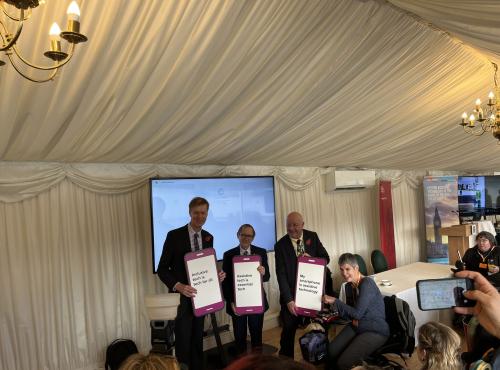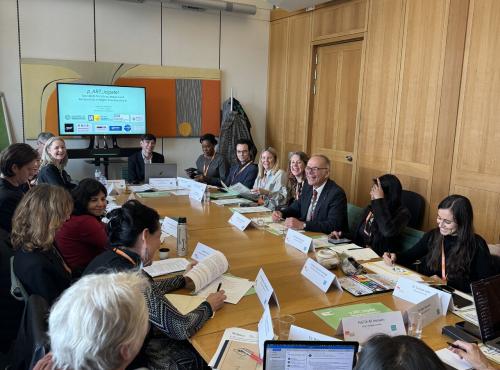Design and the Future of Intellectual Property Rights
The All-Party Design and Innovation Group (APDIG) held their first meeting of 2020 and the new Parliament on how Intellectual Property (IP) rights are being affected by Brexit and a rapidly changing world economy.
The Design Council have noted that it is common for a single product to have more than one type of protection. Consider an Aero chocolate bar as an example. A simple thing, but full of IP. The name AERO will be a trademark, the shape of the bar might be protected as a registered design, the artwork on the packaging might be protected by copyright or designs, and that clever way they put the bubbles inside used to be covered by a patent.
The event was led by APDIG Co-Chair, Barry Sheerman MP, and began with opening presentations by Luke Hamm of the R&D tax consultancy, GovGrant, and Dids Macdonald, Chief Executive of Anti-Copying in Design (ACID).
In his opening remarks, Mr Sheerman noted the importance of IP rights arising from Brexit, and the impact that it was likely to have on future trade deals and mutual recognition of standards. He added that the calls for new trading links with the United States, China and India was likely to have a major impact on how British intellectual property rights were viewed and would have corresponding impacts on the copyright protections currently available to British companies and inventors.
Mr Hamm began with noting the importance of IP in protecting SMEs and other small organisations from litigation, as well as how to make these firms aware of the need to bridge the gap between design-led products and wider industry bodies. He said that it was also vital to impart awareness of what IP means, as well as the need to ensure that it was at the top of the agenda for boardrooms and all design agencies.
Dids Macdonald of ACID opened her remarks by noting that IP acted as positive force for growth across the United Kingdom. She highlighted the tremendous economic benefits of design to the wider British economy, as well as the contribution made across a range of different elements of the economy. She added that it was vital to point out that better enforcement of IP rights was vital to protect jobs, but said that the UK had a tremendous amount of successful and strength within the wider British economy. In the new Parliament, Ms Macdonald said IP would be more important than ever, and that IP could be used to improve firm’s legal standing in the wider world.
In a recent letter to the Prime Minister, published in the industry magazine, Design Week, ACID had had highlight these priorities. Other matters of concern to the sector include the importance of IP being considered as vital to any future trading deals, especially with the EU. It also calls for the reintroduction of a dedicated Minister for IP serving in government.
Mr Sheerman opened questions to other attendees. A common areas raised by members was how to improve awareness of the value of IP to businesses. Sandra Booth of the Council for Higher Education in Art and Design (CHEAD) and Ha Smith of Ravensbourne University both noted that design and engineering students are increasingly taught about the importance of IP as part of their studies, but that provision for this was scrappy across the sector as a whole. Many universities now provide incubation centres to help students and recent graduates to develop products for commercial purposes. However, the number of students being taught about the principles of IP law is very low.
Clive Flood of GovGrant noted that no university MBA courses in the United Kingdom include UP as a core component, despite the value it offers across all sectors of the business economy.
A number of attendees, including Tony Ryan of the D&T Association, raised the possibility of intellectual property being introduced at the secondary school level. Mr Sheerman added that proactive rules on this could only come from best practice elsewhere, highlighting a need for industry leaders and lawmakers to learn from example. He noted a number of positive examples from the sector, such as the Royal College of Art and the University of Bradford.
Rhian Deakin of the architectural firm, Foster and Partners, said that many of these areas were difficult to break down for industry members, especially in architecture, but that more needed to be done to make this accessible. She said that the legal challenges for a large architectural firm were large enough and were clearly almost insurmountable for the SMEs that otherwise dominate the design sector.
Caroline Jackman of the Crafts Council added that the sector needed to be more proactive rather than reactive in terms of highlighting the importance of IP rights. Ms Macdonald added that firms needed to take more time to communicate IP more effectively to industry figures and members of the public alike. It was important – she said – to put a level of value on the output from designers and allowing them to profit from their own creations.
GovGrant’s Luke Hamm noted that the main reasons for individuals and small firms not taking IP into account was usually down to the expensive and time-consuming nature of doing so. He that more needed to be done to ensure that the risks associated with design rights, especially design rights, could be moved to other areas of the economy. He said that for some sectors, such as pharma, IP was second nature. Countries ranging from Cyprus to South Korea have increased the scope of R&D Tax Credits in recent years to take into account firms working in software areas such as blockchain. A review of the current nature of the sector was seen as being vital for future growth and protection.
There was consensus amongst all attendees that policy makers and parliamentarians needed to developer closer links with the Intellectual Property Office. There was a view that awareness of design and the design sector needed to be improved within the IPO. Dids Macdonald noted the success of the Design Council’s Design Economy reports as playing a positive role in this respect, but added that more needed to be done to demonstrate the benefits of design to policy makers from outside the creative industries.
Other priorities that were discussed included developing a more streamlined process for protecting against IP infringement, especially the deterrent associated with Unregistered Design Rights. Some of the protections for this that were the Intellectual Property Act of 2014 were deemed to represent a positive step, but more needed to be done. Others also discussed the value of the Irish Government’s “Knowledge Box” approach towards encouraging commercialisation of new product ideas.
It was also noted that with technological developments such as blockchain and 3D printing that legal processes association with product design needed to adapt rapidly to a changing scientific economy.
In 2020, the APDIG will seek to prioritise developments in the area of IP, including developing an accessible report for policy makers on the subject, as well as working towards a possibility submission to HM Treasury ahead of the Spring Budget.



